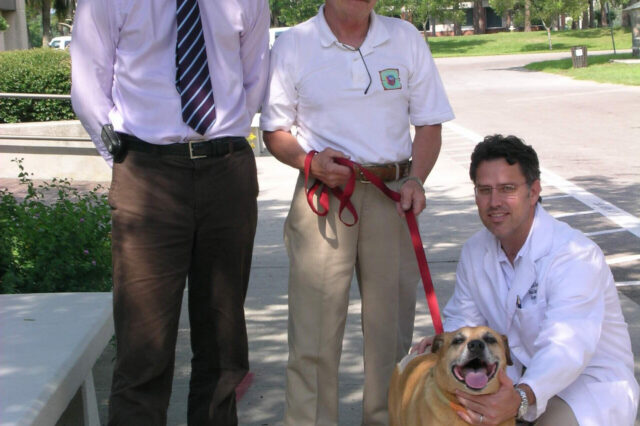Radiosurgery procedure used successfully to treat dog's prostate cancer

Drs. Nick Bacon, left and Jim Farese, right, pose with William Lassiter and Corey prior to the dog’s discharge from UF’s Veterinary Medical Center in July following successful stereotactic radiosurgery to treat Corey’s prostate cancer. (Photo by Sarah Carey)
Since William Lassiter rescued Corey, then a pathetic-looking, mixed-breed dog he first spotted outside a pawn shop eight years ago, the two have been inseparable.
"The shop had lots of (weed trimmers) and chainsaws," said Lassiter, a former medical malpractice attorney who retired from his Jacksonville firm in 2000 and now lives on 380 acres near Melrose. "I'd just bought a farm and needed some equipment, so I whipped in impulsively one day and saw a brown dog chained to a tree nearby. The owner said a man had left the dog there that morning, and that the dogcatcher would be taking him to the pound in about an hour."
Lassiter went over to the dog, whom he said looked "crestfallen," loaded him into his jeep and took the animal home. Since then Corey has lived happily with Lassiter and three other family dogs, riding shotgun in his owner's truck around the property every day until late June, when he suddenly began to have trouble using the bathroom.
"He was in distress, so I called the vet," Lassiter said. After two weeks in a veterinary hospital in Interlachen, tissue samples were sent to the University of Florida's Oncology Service to determine whether Corey had prostate cancer. The diagnosis was positive.
"I brought Corey to UF and everyone was very prompt and gave me a number of options, none of which were acceptable," Lassiter said. "I wasn't ready for Corey to go to the Rainbow Bridge."
UF oncology veterinarians then came up with another idea, worth trying on the chance Corey could be saved. The idea was to use stereotactic radiosurgery, a technique used in oncology cases in canine patients with brain, nasal, bone and urethral cancer, but never previously attempted to target a tumor in the prostate gland.
Corey's cancer had spread to a lymph node and this was first removed by the oncology surgeons. Then, in collaboration with Frank Bova, a professor of neurosurgery at UF's McKnight Brain Institute, a high dose of radiation was delivered to the cancerous prostate. Corey recovered well from the procedure, and UF medical oncology veterinarians are now treating him with chemotherapy. So far, so good, Lassiter said.
"He's alert and he's happy," said Lassiter, a cancer survivor himself. "The expertise right here in Gainesville is none other than world-class, and they are way ahead of everybody in this procedure. Corey was just very fortunate to find himself at UF with these incredible doctors. The UF people really have an esprit de corps, and it shows."
Nick Bacon, D.V.M., who operated on Corey at UF and was involved along with other members of the school's oncology team, called Lassiter "an amazing individual."
"He fought his own cancer head-on and beat it," Bacon said. "He now just wants to give his best friend, Corey, the same chance. I'm pleased the team here was able to help them both and at the same time we benefit because we learn more about treating prostate cancer in dogs. We all win."
About the author
